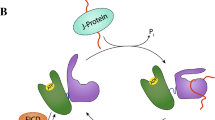Abstract.
Efficient protein folding and quality control in the endoplasmic reticulum (ER) require that disulphide bonds are formed in nascent proteins, isomerised during assisted folding and reduced in terminally misfolded molecules. Recent findings in yeast and mammalian cells indicate that specific protein–protein interactions underlie redox control in the ER, allowing these competing reactions to occur simultaneously during protein quality control.
Similar content being viewed by others
Author information
Authors and Affiliations
Additional information
Electronic Publication
Rights and permissions
About this article
Cite this article
Fassio, A., Sitia, R. Formation, isomerisation and reduction of disulphide bonds during protein quality control in the endoplasmic reticulum. Histochem Cell Biol 117, 151–157 (2002). https://doi.org/10.1007/s00418-001-0364-0
Accepted:
Published:
Issue Date:
DOI: https://doi.org/10.1007/s00418-001-0364-0




